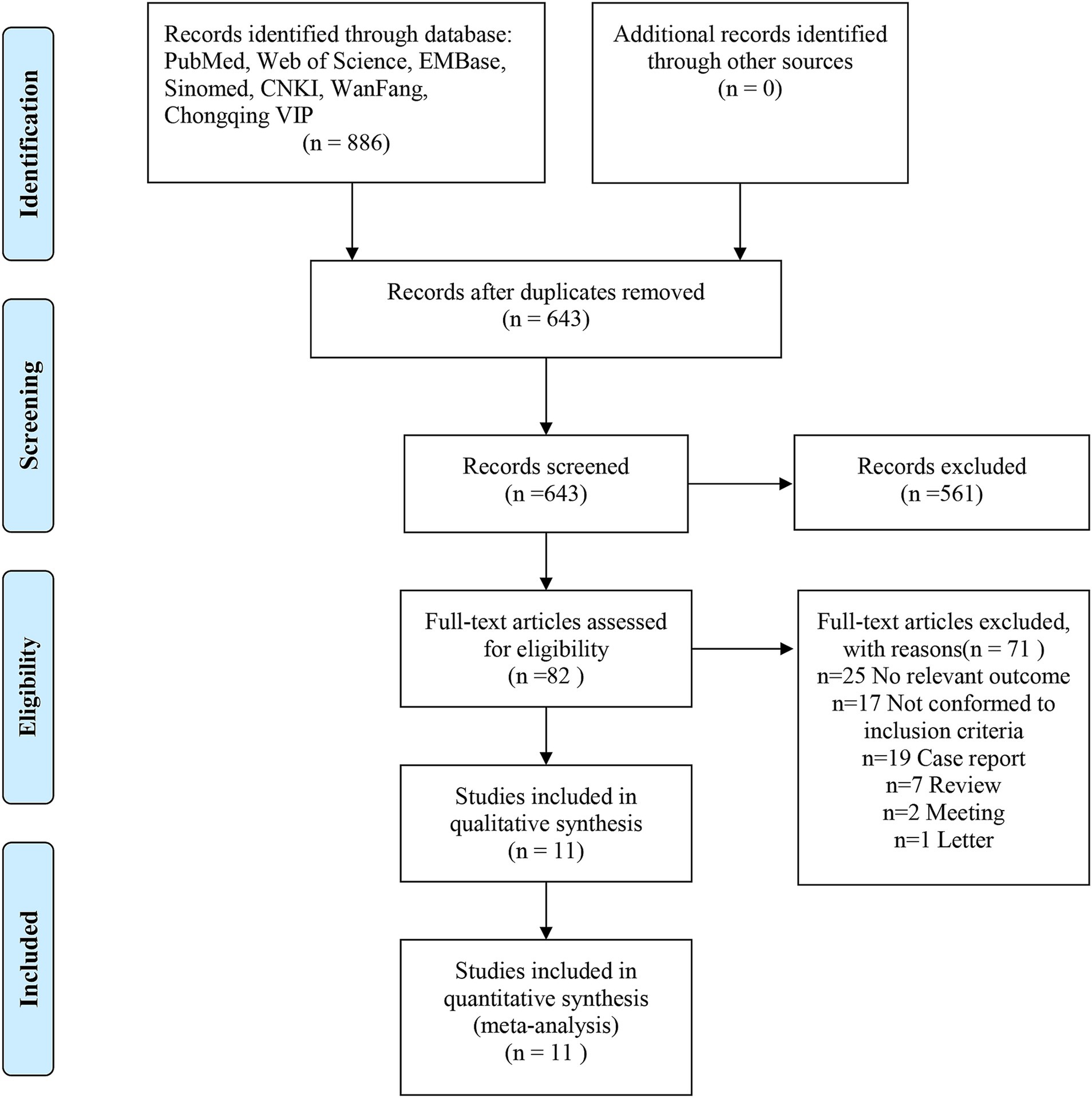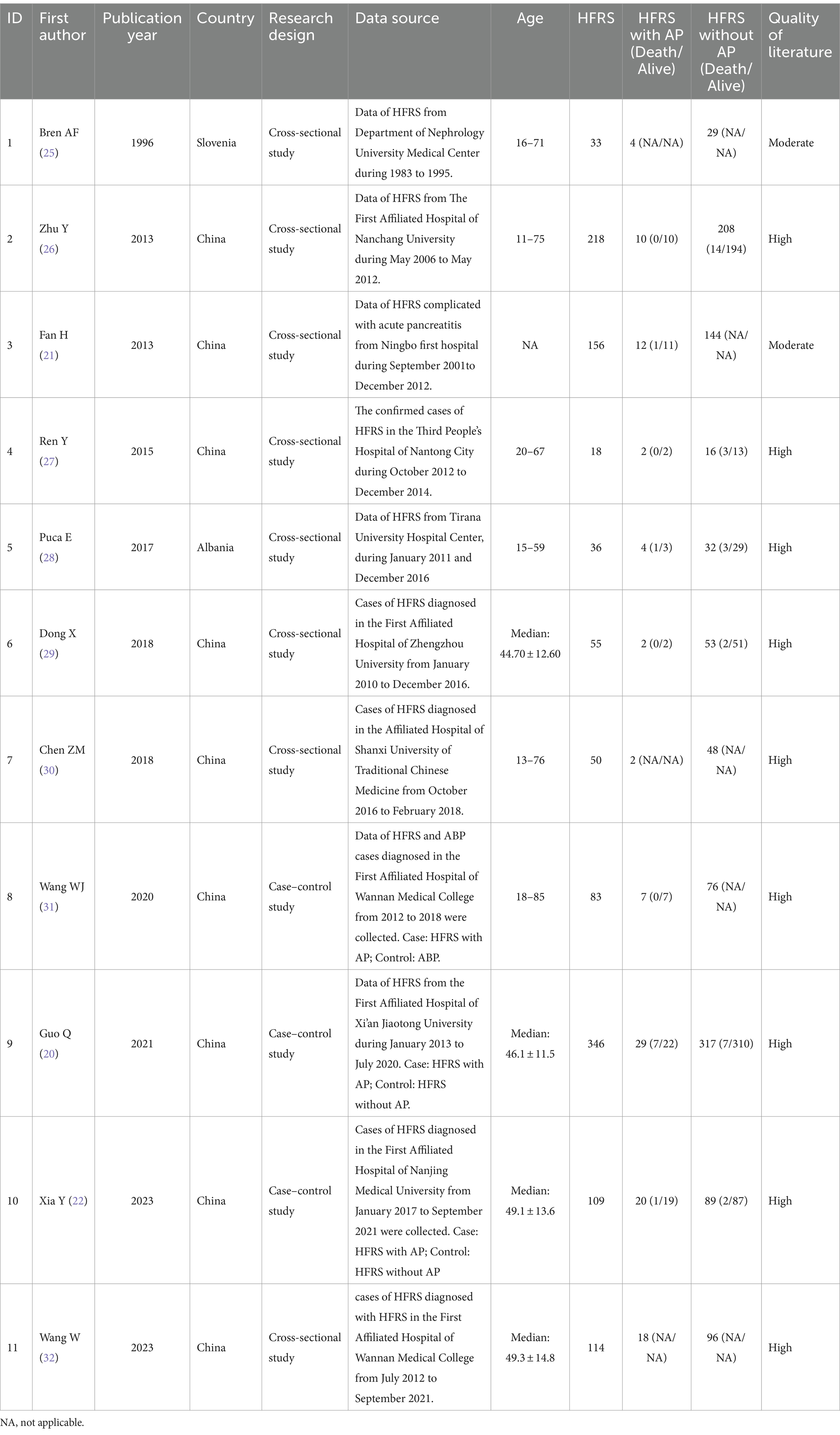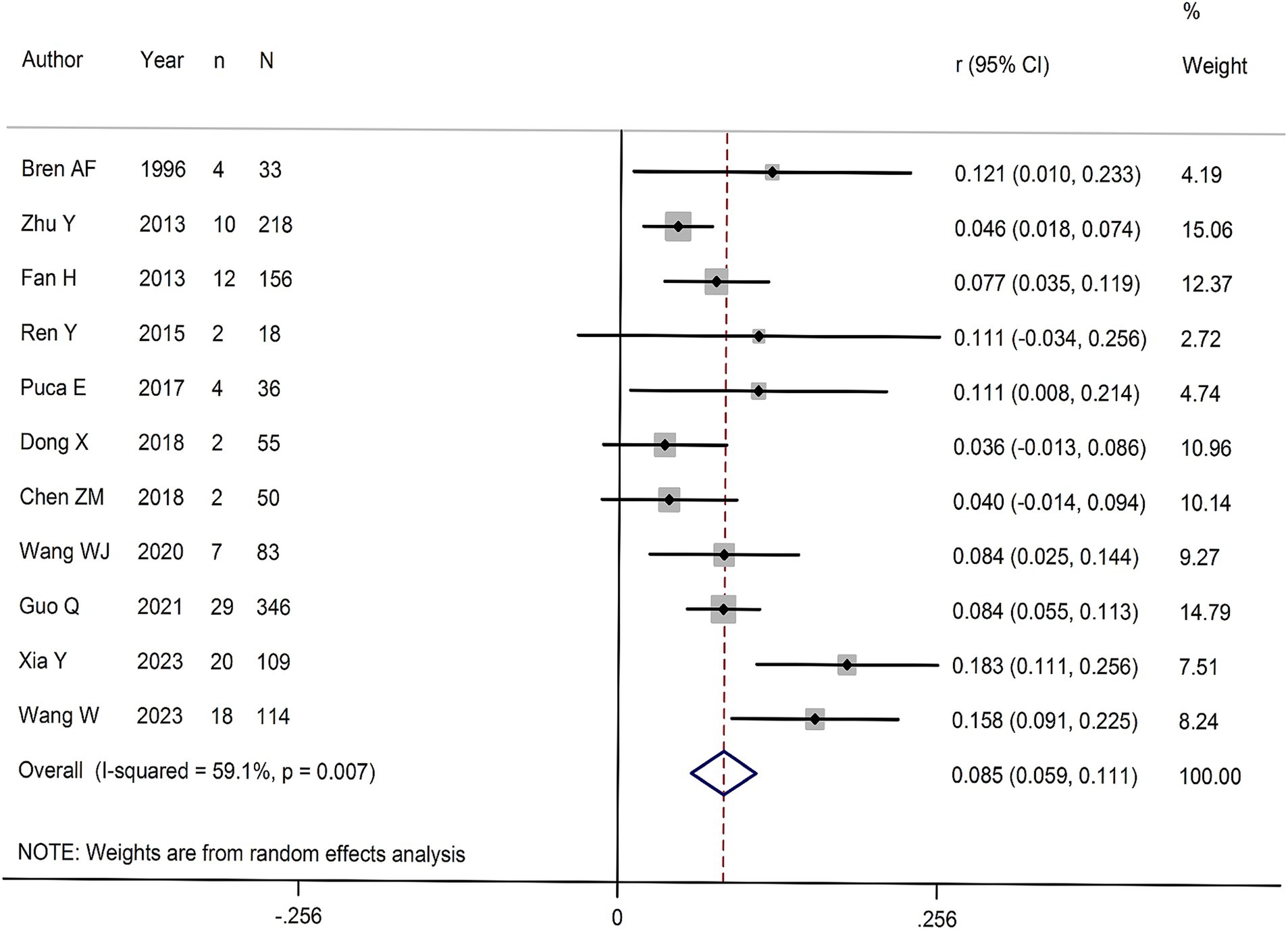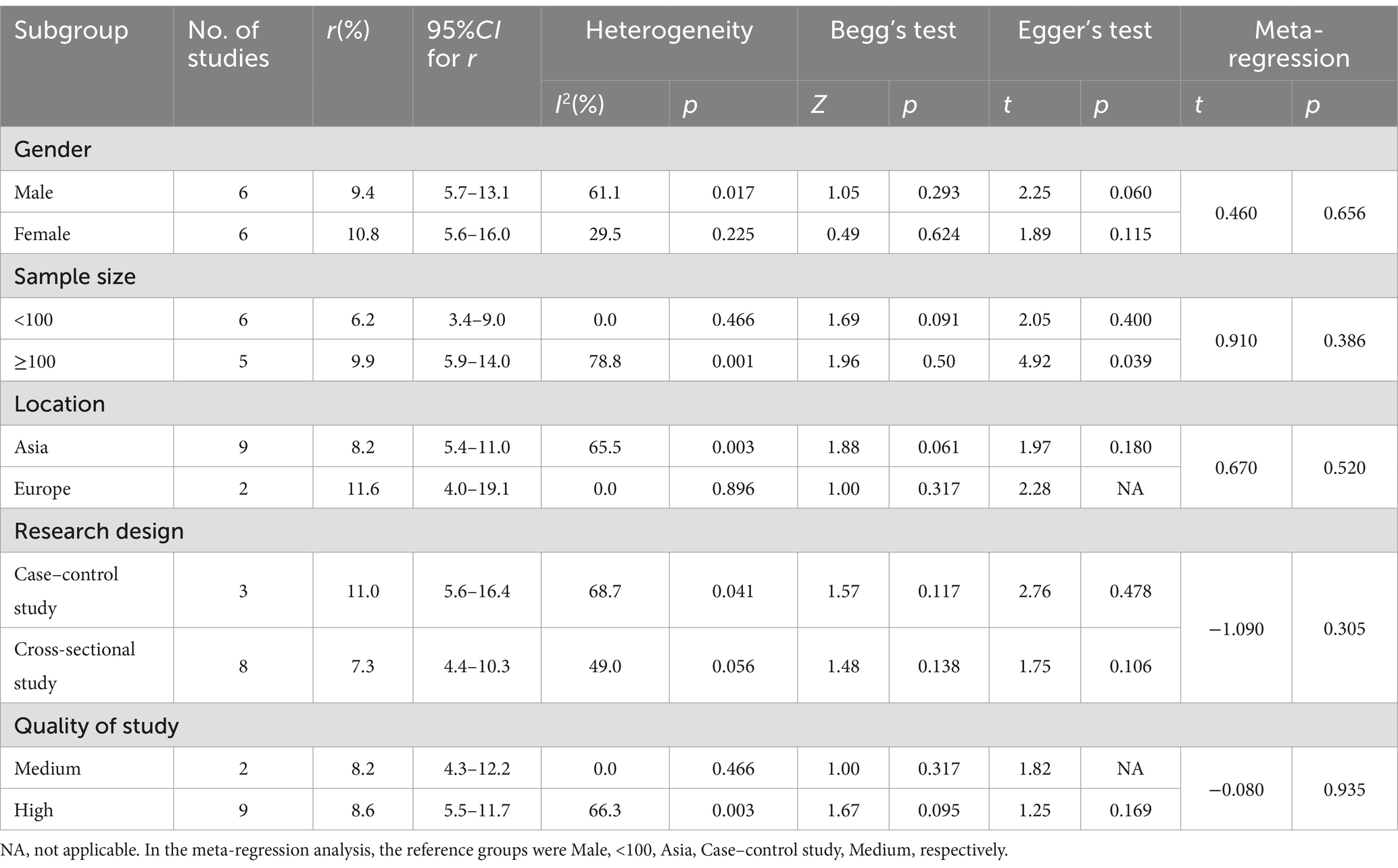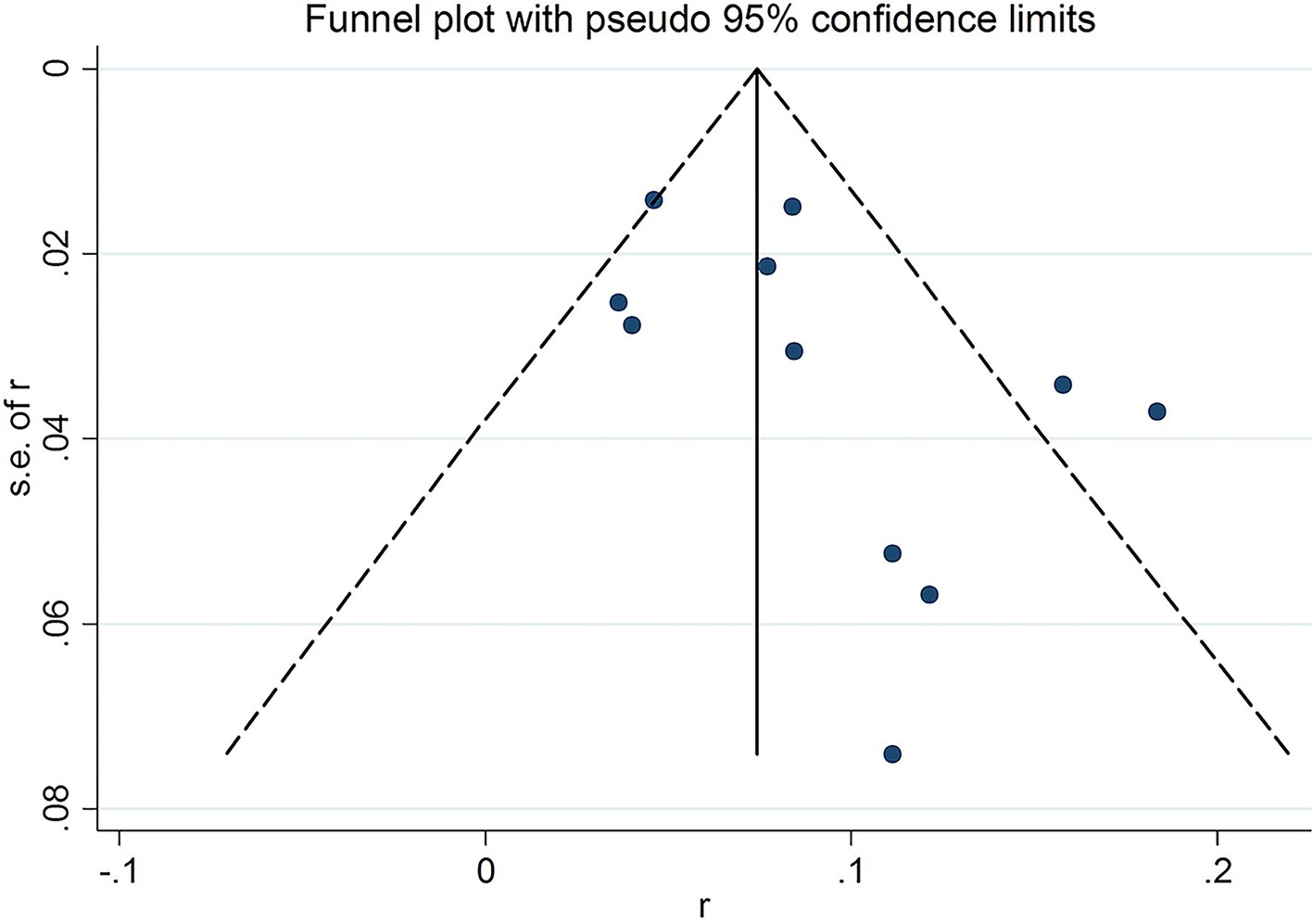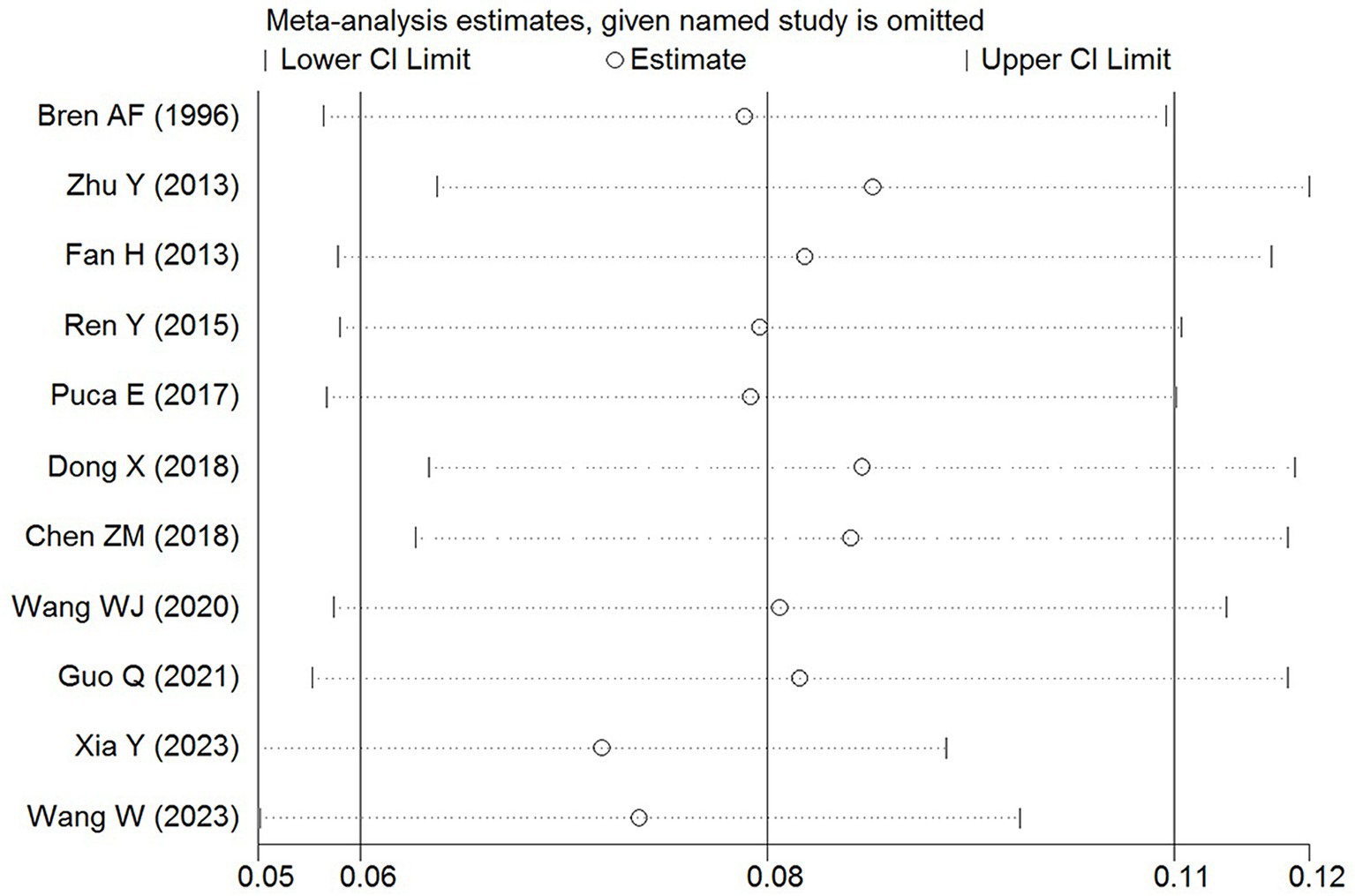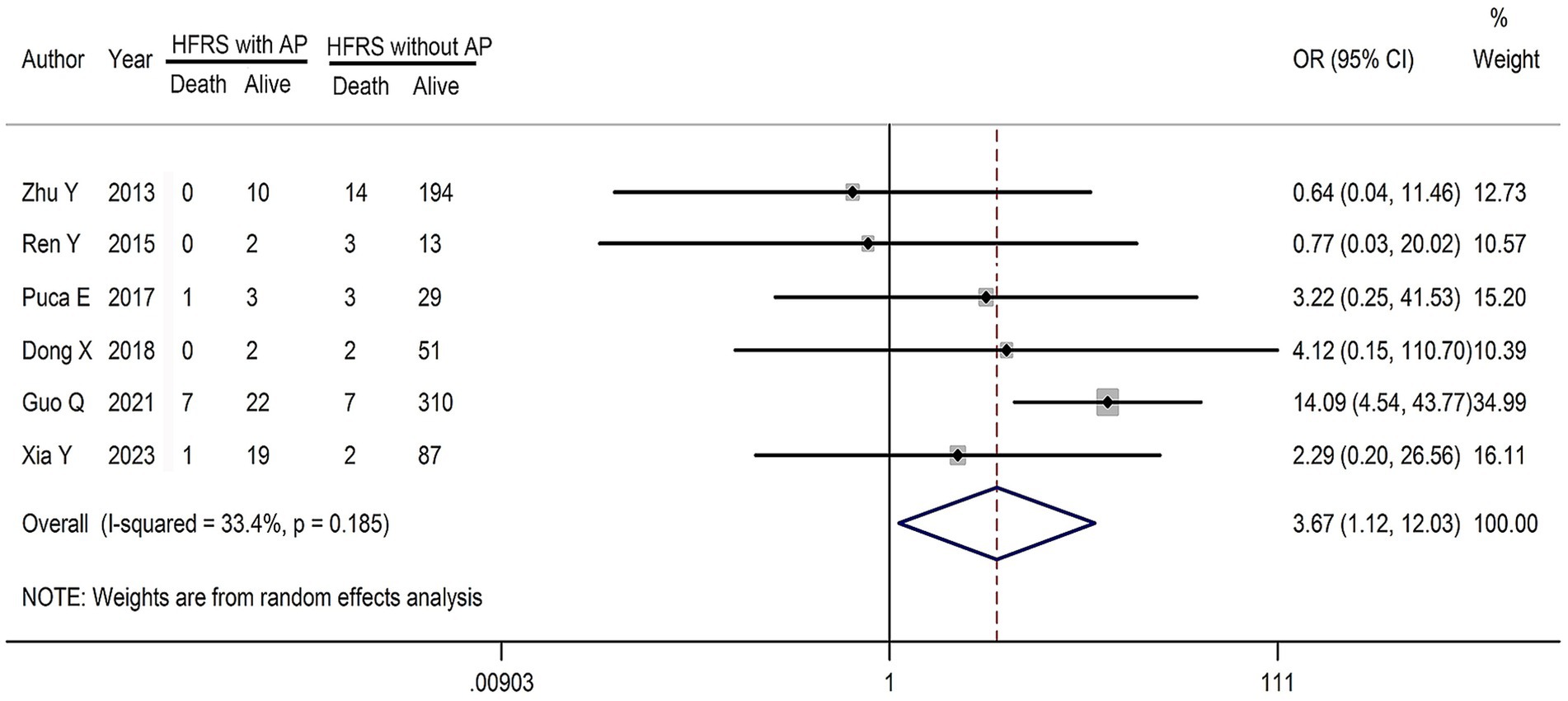- 1Youth Research and Innovation Team of Jiangxi Provincial Center for Disease Control and Prevention, Nanchang, Jiangxi, China
- 2Prevention Rural Environmental Health Technical Guidance Center of Jiangxi Provincial Center for Disease Control, Nanchang, Jiangxi, China
- 3Jiangxi Province Key Laboratory of Major Epidemic Prevention and Control, Nanchang, Jiangxi, China
Background: Acute pancreatitis (AP) is a rare but serious complication in patients diagnosed with hemorrhagic fever with renal syndrome (HFRS). When AP complicates HFRS, the clinical outcome significantly worsens and the risk of mortality increases. However, the incidence of AP in HFRS patients and its associated mortality risk remain unclear. To address this knowledge gap, we conducted a meta-analysis to determine the AP incidence rate in HFRS patients and assess the impact of AP on mortality in these patients.
Methods: We systematically searched seven databases (PubMed, Web of Science, EMBase, Sinomed, Chinese National Knowledge Infrastructure, WanFang Data, and Chongqing VIP) for relevant studies on HFRS complicated by AP. The studies were selected using predefined inclusion and exclusion criteria based on the Population, Intervention, Comparison, Outcome, and Study design principle. Two independent reviewers screened the studies, and the quality of the included studies was assessed using the Agency for Healthcare Research and Quality and the Newcastle-Ottawa Evaluation Scale (NOS).
Results: In total, 11 studies, encompassing 1,218 HFRS patients, met the inclusion criteria. The overall incidence of HFRS complicated by AP was 8.5% (95% CI for r 5.9–11.1%). The HFRS patients with AP had a significantly higher risk of mortality than those without AP (OR = 3.668, 95% CI for OR 1.112–12.031). No statistically significant differences were observed in the subgroup and meta-regression analyses.
Conclusion: Although the incidence of AP in HFRS patients is not high, it significantly increases the risk of mortality in these patients. Future large-scale prospective studies are required to further validate these findings.
1 Introduction
Hemorrhagic fever with renal syndrome (HFRS) is a rodent-borne zoonotic disease caused by hantaviruses (1). Initially classified under the genus Hantavirus within the Bunyaviridae family, the latest taxonomy now places hantaviruses responsible for HFRS under the genus Orthohantavirus of the Hantaviridae family within the order Bunyaviridae (2). Humans are typically infected through the inhalation of aerosols formed from rodent excretions or secretions contaminated with hantavirus or by ingesting contaminated food (3, 4). Suspected cases of HFRS were first reported in Russia, Japan, and China in the 1920s. However, it was not until the Korean War in the 1950s, when more than 3,000 United Nations soldiers fell ill, that the disease garnered widespread attention (5–7). Currently, more than 100,000 cases of HFRS are estimated to be reported globally each year (8). Because hantavirus infections go unreported in many countries, the actual number of HFRS cases may be higher (9). HFRS has a global distribution, with Europe and Asia being the primary areas of prevalence (10, 11). According to reports, from 2000 to 2017, Russia reported an HFRS incidence of 4.9 per 100,000 people; in China, the rate was 0.9 per 100,000 between 2004 and 2021, while South Korea reported an incidence of 0.8 per 100,000 from 2001 to 2010 (12–14).
The case fatality rate of HFRS varies widely, ranging from 1 to 15% (15). The mortality risk increases substantially when HFRS is complicated by other conditions (16, 17). Common complications in HFRS patients include cerebral edema, pulmonary edema, luminal hemorrhage, and infections. Although less common, acute pancreatitis (AP) has also been reported in HFRS patients. AP is a severe condition characterized by inflammation of the pancreas, often leading to multiple organ failure and death if not diagnosed and treated promptly (18). When HFRS patients develop AP, their condition becomes far more complex and dangerous, with the potential for rapid deterioration and an elevated risk of mortality (19). In Guo Q’s study (20), the fatality rate of patients with HFRS complicated by AP was 24.1%, whereas that of HFRS patients without AP was only 3.5%. This underscores the significant risk that AP poses to HFRS patients, highlighting the significance of timely diagnosis and treatment of AP in HFRS patients.
Currently, systematic evaluation of the incidence of AP in HFRS patients has been insufficient, which negatively affects the clinical treatment of these patients. Fan H (21) reported an incidence of 7.7% for HFRS combined with AP, while Xia Y (22) reported a considerably higher incidence of 18.3%. These discrepancies are likely due to differences in sample size, study design, and geographic location. We hypothesize that HFRS patients with AP will have a higher mortality rate than those without AP and that the incidence of AP in HFRS patients may vary depending on regional factors, sample size, and study methodology. To understand the incidence of AP in HFRS patients and its impact on mortality, we conducted a meta-analysis based on published studies examining the association of HFRS with AP. The objectives of our meta-analysis are to provide a comprehensive analysis of the present study and to offer insights that can inform clinical diagnosis and treatment strategies for HFRS patients with this complication.
Although some studies have explored HFRS and its complications, including AP, a clear understanding of the incidence and associated mortality risk remains elusive. The variability in study methodologies and the absence of a synthesized analysis across different populations and geographic regions have contributed to this gap in knowledge. Our study addresses this limitation by conducting a systematic meta-analysis, offering a novel approach to evaluate these factors comprehensively—a method that has been unexplored in current literature.
2 Materials and methods
2.1 Search strategy
A comprehensive literature search was conducted across multiple databases, namely PubMed, Web of Science, EMBase, Sinomed, Chinese National Knowledge Infrastructure, WanFang Data, and Chongqing VIP, between March and September 2024 to identify all relevant studies on HFRS complicated by AP. The search terms used were a combination of keywords related to HFRS and AP: (“Hemorrhagic Fever with Renal Syndrome” OR “HFRS” OR “Epidemic Hemorrhagic Fever” OR “Nephropathia Epidemica” OR “Hemorrhagic Nephroso Nephritis” OR “Korean Hemorrhagic Fever”) AND (“Pancreatitis” OR “Acute Pancreatitis” OR “Complications” OR “Coexistent disease” OR “Prognosis” OR “Prognostic Factor”). Two independent reviewers screened the literature, beginning with titles and abstracts, followed by a full-text review. Additionally, references of the included studies were examined for further relevant studies. No language restrictions were applied during the selection process.
2.2 Inclusion criteria
In this study, the inclusion and exclusion criteria were developed based on the Population, Intervention, Comparison, Outcomes, Study Design principle. Studies that met the following criteria were included in this meta-analysis: (1) Studies involving HFRS patients diagnosed using one or more of the following criteria: positive serum-specific IgM or a fourfold increase in serum-specific IgG between the acute and recovery phases, detection of hantavirus RNA in the patient’s specimen, or isolation of hantavirus from the patient’s specimen. The diagnostic criteria for AP included serum lipase or amylase levels elevated, three or more times the upper limit of normal, and imaging features of AP on enhanced computed tomography, magnetic resonance imaging, or transabdominal ultrasound. (2) Studies providing data on HFRS patients complicated by AP. (3) Studies with prospective or retrospective, designs, including cohort studies, case–control studies, and cross-sectional studies. (4) Studies reporting author name, publication date, country of origin, the number of HFRS cases, and the incidence of the number of HFRS cases complicated by AP. Studies were excluded if they met the following criteria: (1) Meetings abstracts, case reports, reviews, letters and duplicate publications. (2) Studies that do not provide information on the incidence of HFRS with AP or where this incidence could not be calculated. Two reviewers independently screened the studies based on the inclusion and exclusion criteria. Any discrepancies in study selection are resolved by consulting a third reviewer.
2.3 Data extraction
In this study, data extraction was performed by one reviewer who was not involved in the initial literature screening. Another reviewer then checked the data and contacted the authors of the included studies to resolve any missing or incomplete information. The data extracted included the first author details, year of publication, study region, study design, patient demographics (sex and age), total number of HFRS patients and number of patients with HFRS complicated by AP or incidence of HFRS complicated by AP.
2.4 Quality assessment of the studies
The methodological quality of the included studies was independently assessed by two reviewers. For cross-sectional studies, the Agency for Healthcare Research and Quality (AHRQ) scale was used (23), which consists of 11 items. Each “yes” response was awarded 1 star (*), with a maximum score of 11 stars. The studies were categorized as follows: 0–3 stars were rated as low quality, 4–7 stars as moderate quality, and 8–11 stars as high quality. For cohort and case–control studies, the Newcastle-Ottawa Evaluation Scale (NOS) (24) was employed, which evaluates studies based on comprising eight items grouped into three categories. The NOS uses a star system, with a maximum of nine stars. The studies were rated as follows: 0–3 stars were rated as low quality, 4–6 stars as moderate quality, and 6–9 stars as high quality.
2.5 Statistical analyses
Meta-analysis was conducted using Stata 13.0 software. The pooled incidence rate and 95% confidence interval (CI) were used to evaluate the effect. Heterogeneity among different studies was assessed using Cochran’s Q test and the I2 statistic. Heterogeneity was considered present when p < 0.05 or I2 > 50%, in which case a random-effect model was employed to combine the effect estimates. Otherwise, a fixed-effect model was used. Subgroup analysis was performed based on study region, study design, gender, and methodological quality to explore potential sources of heterogeneity. Sensitivity analysis was conducted to evaluate the robustness of the results. Publication bias was assessed using a Funnel plot, Begg’s test, and Egger’s test. A two-tailed p value <0.05 was considered statistically significant.
3 Results
3.1 Study selection and characteristics
Using the search strategy, a total of 886 relevant studies were identified. After removing duplicates, 643 studies remained. Screening of titles and abstracts led to the exclusion of 561 irrelevant studies, leaving 82 studies for full-text review. Based on the eligibility criteria, 71 studies were excluded, and 11 studies were included in the final meta-analysis (Figure 1).
Among the 11 included studies (20–22, 25–32), seven were published in English and four in Chinese. Geographically, nine studies were from China, 1 from Albania, and one from Slovenia. The analysis included three case–control studies and 8 cross-sectional studies. Ten studies provided the age of the participants, whereas one study did not. Six studies reported mortality data comparing HFRS patients with and without AP, whereas the remaining studies did not provide or were unable to calculate death-related data. After assessing the quality using AHRQ and NOS, nine studies were rated as high quality and two as moderate quality. Overall, the studies included in this meta-analysis were of high methodological quality. The basic characteristics of the included studies are presented in Table 1.
3.2 Overall incidence of HFRS complicated with AP
A total of 1,218 HFRS patients were reported across the 11 studies, of which 110 patients had AP. The incidence of HFRS combined with AP ranged from 3.6 to 18.3%. Five of the 11 studies report AP incidence of >10%, and 6 studies reporting an AP incidence of ≤10%. Significant heterogeneity was observed among the studies (Q = 24.44, p < 0.001; I2 = 59.1%). Therefore, a random effects model was used to calculate the pooled effect size (Figure 2). The overall incidence of HFRS complicated with AP was 8.5% (95% CI for r 5.9–11.1%; Z = 6.40, p = 0.001).
3.3 Subgroup analyses
Subgroup analysis was conducted based on gender, sample size, region, study design, and methodological quality (Table 2). The incidence of HFRS with AP was 9.4% (95% CI for r 5.7–13.1%) in males and 10.8% (95% CI for r 5.6–16.0) in females. The incidence of HFRS with AP was 6.2% (95% CI for r 3.4–9.0%) in studies with a sample sizes of <100, and 9.9% (95% CI for r 5.9–14.0%) in studies with a sample size of ≥100. Regarding regional distribution, the incidence of HFRS with AP was 8.2% (95% CI for r 5.4–11.0%) in Asia and 11.6% (95% CI for r 4.0–19.1%) in Europe. The incidence of HFRS with AP was 11.0% (95% CI for r 5.6–16.4%) in case–control studies and 7.3% (95% CI for r 4.4–10.3%) in cross-sectional studies. Regarding different methodological quality grades, the incidence of HFRS with AP was 8.6% (95% CI for r 5.5–11.7%) in high quality studies and 8.2% (95% CI for r 4.3–12.2%) in moderate quality studies.
To investigate the heterogeneity among the included studies, statistical comparisons were made between the subgroups. Meta-regression analysis results were present in Table 2, and no statistically significant differences were observed among the various subgroups. The results of the subgroup analysis and meta-regression suggesting a high degree of homogeneity across all included studies. Nevertheless, unrecognized clinical and methodological heterogeneity, or other unknown factors, may still exist. Given the relatively limited number of studies included in this analysis, the findings should be interpreted with caution.
3.4 Publication bias
To assess potential publication bias, a funnel plot was generated, which visually showed an asymmetrical distribution of the included studies (Figure 3). Despite this, statistical tests, including Begg’s test (Z = 1.71, p = 0.087) and Egger’s test (t = 1.82, p = 0.102), revealed no significant evidence of publication bias. Altogether, both subjective and objective evaluations suggested that publication bias was not present in this study.
3.5 Sensitivity analysis
Sensitivity analysis was conducted to evaluate robustness and stability of the results. By systematically excluding each study and recalculating the pooled effect size, we determined that the overall incidence of HFRS complicated with AP remained stable after the exclusion of any individual study. This confirms the reliability of the findings (Figure 4).
3.6 Risk of death in HFRS patients with AP
This study also assessed the mortality risk in HFRS patients with AP compared with those without AP, using mortality as the outcome indicator. Six studies reported mortality data, with the mortality rate for HFRS combined with AP ranging from 0.0 to 25.0%, while that for HFRS without AP ranging from 2.2 to 18.8%. The effect sizes (OR) among the various studies ranged from 0.639 to 14.091. No significant heterogeneity was found (Q = 7.51, p = 0.185 > 0.05; I2 = 33.4%; Figure 5); therefore, a fixed-effect model was used. The pooled effect size (OR) was 3.668 (95%CI for OR 1.112–12.031, Z = 2.14, p = 0.032 < 0.05). This indicates that the mortality risk in HFRS patients with AP was significantly higher than that in patients without AP.
4 Discussion
Based on the current literature search, we believe that this is the first systematic meta-analysis to comprehensively analyze the occurrence of HFRS combined with AP. In this study, the incidence of HFRS combined with AP was 8.5% (95% CI for r 5.9–11.1%), which, while not exceedingly high, underscores the significance of clinical vigilance in these cases. The pathogenesis of AP in HFRS patients may involve multiple factors. Hantavirus may directly damage pancreatic tissues, while the release of inflammatory mediators and immune system dysregulation may exacerbate pancreatic injury. Clinicians should be particularly alert to the potential for AP in HFRS patients who present with abdominal pain, a history of alcohol consumption, and signs such as abnormal coagulation hypoalbuminemia, thrombocytopenia, elevated lymphocyte ratios, or high levels of proteinuria (33, 34).
The incidence of AP in HFRS patients was 9.4% in males and 10.8% in females, aligning with prior research that also found no marked gender disparity in AP incidence (35, 36). However, the incidence of AP varied depending on the sample size. The studies with sample size of ≥100 reported a higher incidences of AP than studies with a sample size of <100. Regarding regional distribution, the incidence of AP in HFRS patients was higher in Europe than in Asia. However, as the present study only included two European datasets, the sample size may have been too small to draw definitive conclusions. Generally, the larger the sample size, the more stable the results of the relative number calculation (37, 38). Therefore, larger studies across various regions are needed to refine the understanding of geographic variability in AP incidence among HFRS patients. The incidence of AP in case–control studies was higher than cross-sectional studies. This may be due to the admission bias and detected syndrome bias in the selection of subjects in case–control studies, resulting in more reported cases of HFRS with AP (39).
In addition to the primary findings, an analysis of six studies reporting on mortality revealed that HFRS patients with AP had a higher significantly risk of mortality than those without AP (OR = 3.668, 95% CI for OR 1.112–12.031). Two potential reasons for this increased risk have been proposed. First, HFRS patients may experience more severe inflammation, leading to more frequent liver dysfunction and increasing the likelihood of developing into critical or severe cases (40). Second, HFRS complicated with AP is often misdiagnosed due to its nonspecific clinical manifestations and failure to timely treatment increases the mortality risk (41). Because most patients with HFRS exhibit nonspecific clinical manifestations, their typical symptoms are primarily characterized by gastrointestinal system symptoms, such as fever, nausea, vomiting, abdominal pain, and abdominal distension, that overlap with gastrointestinal disorders such as AP. This diagnostic overlap can delay appropriate treatment, further elevating the mortality risk. Consequently, clinicians should exercise caution in ruling out the possibility of AP in HFRS patients presenting with fever and abdominal pain.
5 Limitations
The study has several limitations in this study. First, only published studies were included in the meta-analysis, which could result in selection bias, as unpublished or unreported studies were not considered. Second, the studies included in this meta-analysis were mostly from China. This geographic concentration may not fully represent the geographic sample. Third, other potential factors affecting the incidence AP in patients, such as age, lifestyle, or underlying health conditions, could not be fully investigated due to the limited number of studies and the variable quality of available data.
6 Conclusion
The overall incidence of HFRS complicated with AP was 8.5%, while not high, which is concerning because of the significantly increased risk of mortality for HFRS patients when AP is present. In the future, additional large-scale prospective studies are warranted to determine the incidence of HFRS with AP and the associated mortality risk.
Author contributions
ZY: Writing – review & editing, Conceptualization, Writing – original draft. XL: Conceptualization, Writing – review & editing, Funding acquisition. SD: Writing – review & editing, Project administration. LL: Project administration, Writing – review & editing. TZ: Software, Data curation, Writing – review & editing. WZ: Writing – review & editing, Software. YD: Conceptualization, Writing – review & editing, Writing – original draft.
Funding
The author(s) declare that financial support was received for the research, authorship, and/or publication of this article. This research was supported by the National Natural Science Foundation of China (Grant No. 82360661), the Leading Medical Discipline (Epidemiology) of Jiangxi Province, Jiangxi Province Key Laboratory of Major Epidemic Prevention and Control (Grant No. 2024SSY06021), and Science and Technology Department of Jiangxi Province, China (Grant No. 20224ABC03A14).
Acknowledgments
We extend our gratitude to all members of the research team for their invaluable contributions, which were essential for the successful completion of our study.
Conflict of interest
The authors declare that the research was conducted in the absence of any commercial or financial relationships that could be construed as a potential conflict of interest.
Publisher’s note
All claims expressed in this article are solely those of the authors and do not necessarily represent those of their affiliated organizations, or those of the publisher, the editors and the reviewers. Any product that may be evaluated in this article, or claim that may be made by its manufacturer, is not guaranteed or endorsed by the publisher.
References
1. She, K, Li, C, Qi, C, Liu, T, Jia, Y, Zhu, Y, et al. Epidemiological characteristics and regional risk prediction of hemorrhagic fever with renal syndrome in Shandong Province, China. Int J Environ Res Public Health. (2021) 18:8495. doi: 10.3390/ijerph18168495
2. Abudurexiti, A, Adkins, S, Alioto, D, Alkhovsky, SV, Avšič-Županc, T, Ballinger, MJ, et al. Taxonomy of the order Bunyavirales: update 2019. Arch Virol. (2019) 164:1949–65. doi: 10.1007/s00705-019-04253-6
3. Zhao, WY, Guo, XY, Wang, Y, Shi, HN, Wu, XQ, Yang, YQ, et al. Epidemiological characteristics and influencing factors of hemorrhagic fever with renal syndrome in Weifang City, Shandong Province from 2013 to 2020. Modern Preventive Med. (2023) 50:2651–5. doi: 10.20043/j.cnki.MPM.202301356
4. Su, F, Liu, Y, Ling, F, Zhang, R, Wang, Z, and Sun, J. Epidemiology of hemorrhagic fever with renal syndrome and host surveillance in Zhejiang Province, China, 1990-2021. Viruses. (2024) 16:145. doi: 10.3390/v16010145
5. Schmaljohn, C, and Hjelle, B. Hantaviruses: a global disease problem. Emerg Infect Dis. (1997) 3:95–104. doi: 10.3201/eid0302.970202
6. World Health Organ. Hemorrhagic fever with renal syndrome: Memorandum from a WHO meeting. Bull World Health Organ. (1983) 2:269–75.
7. Mustonen, J, Henttonen, H, and Vaheri, A. Hantavirus infections among military forces. Mil Med. (2024) 189:551–5. doi: 10.1093/milmed/usad261
8. Zhang, R, Mao, Z, Yang, J, Liu, S, Liu, Y, Qin, S, et al. The changing epidemiology of hemorrhagic fever with renal syndrome in southeastern China during 1963-2020: a retrospective analysis of surveillance data. PLoS Negl Trop Dis. (2021) 15:e0009673. doi: 10.1371/journal.pntd.0009673
9. Avšič-Županc, T, Saksida, A, and Korva, M. Hantavirus infections. Clin Microbiol Infect. (2019) 21:e6–e16. doi: 10.1111/1469-0691.12291
10. Sehgal, A, Mehta, S, Sahay, K, Martynova, E, Rizvanov, A, Baranwal, M, et al. Hemorrhagic fever with renal syndrome in Asia: history, pathogenesis, diagnosis, treatment, and prevention. Viruses. (2023) 15:561. doi: 10.3390/v15020561
11. Tariq, M, and Kim, DM. Hemorrhagic fever with renal syndrome: literature review, epidemiology, clinical picture and pathogenesis. Kamyŏm. (2022) 54:1–19. doi: 10.3947/ic.2021.0148
12. Tkachenko, EA, Ishmukhametov, AA, Dzagurova, TK, Bernshtein, AD, Morozov, VG, Siniugina, AA, et al. Hemorrhagic fever with renal syndrome, Russia. Emerg Infect Dis. (2019) 25:2325–8. doi: 10.3201/eid2512.181649
13. Deng, XF, Du, S, Huang, X, Wang, Q, Li, AQ, Li, C, et al. Epidemiological characteristics of reported cases of hemorrhagic fever with renal syndrome in China from 2004 to 2021. Disease Surveillance. (2023) 38:70–4.
14. Lee, SH, Chung, BH, Lee, WC, and Choi, IS. Epidemiology of hemorrhagic fever with renal syndrome in Korea, 2001-2010. J Korean Med Sci. (2013) 28:1552–4. doi: 10.3346/jkms.2013.28.10.1552
15. Lu, W, Kuang, L, Hu, Y, Shi, J, Li, Q, and Tian, W. Epidemiological and clinical characteristics of death from hemorrhagic fever with renal syndrome: a meta-analysis. Front Microbiol. (2024) 15:1–9. doi: 10.3389/fmicb.2024.1329683
16. Jiang, H, Du, H, Wang, LM, Wang, PZ, and Bai, XF. Hemorrhagic fever with renal syndrome: pathogenesis and clinical picture. Front Cell Infect Microbiol. (2016) 6:1. doi: 10.3389/fcimb.2016.00001
17. Zou, LX, and Sun, L. Analysis of hemorrhagic fever with renal syndrome using wavelet tools in mainland China, 2004-2019. Front Public Health. (2020) 8:571984. doi: 10.3389/fpubh.2020.571984
18. Xu, SL, and Liu, JD. Diagnostic value of HBP, SAA and IG% in peripheral blood in acute pancreatitis. J Laboratory Med Clin Sci. (2024) 21:1268–71.
19. Huang, LH, Luo, J, Li, QR, and Gu, W. Hemorrhagic fever with renal syndrome complicated with acute pancreatitis: two cases and literature review. J Dali University. (2020) 5:48–50.
20. Guo, Q, Xu, J, Shi, Q, and Du, B. Acute pancreatitis associated with hemorrhagic fever with renal syndrome: a cohort study of 346 patients. BMC Infect Dis. (2021) 21:267. doi: 10.1186/s12879-021-05964-5
21. Fan, H, Zhao, Y, and Song, FC. Acute pancreatitis associated with hemorrhagic fever with renal syndrome: clinical analysis of 12 cases. Ren Fail. (2013) 35:1330–3. doi: 10.3109/0886022X.2013.828187
22. Xia, Y, Huang, PP, Zhu, Y, and Chen, XF. Clinical characteristics of hemorrhagic fever with renal syndrome complicated with acute pancreatitis. Chin J infect dis. (2023) 9:269–73. doi: 10.3760/cma.j.cn311365-20220921-00399
23. Li, D, Niu, Z, Huang, Q, Sheng, W, and Wang, T. A meta-analysis of the incidence rate of postoperative acute kidney injury in patients with congenital heart disease. BMC Nephrol. (2020) 21:350. doi: 10.1186/s12882-020-02005-2
24. Dong, Y, Li, Z, Ding, S, Liu, S, Tang, Z, Jia, L, et al. HIV infection and risk of COVID-19 mortality: a meta-analysis. Medicine (Baltimore). (2021) 100:e26573. doi: 10.1097/MD.0000000000026573
25. Bren, AF, Pavlovcic, SK, Koselj, M, Kovac, J, Kandus, A, and Kveder, R. Acute renal failure due to hemorrhagic fever with renal syndrome. Ren Fail. (1996) 18:635–8. doi: 10.3109/08860229609047688
26. Zhu, Y, Chen, YX, Zhu, Y, Liu, P, Zeng, H, and Lu, NH. A retrospective study of acute pancreatitis in patients with hemorrhagic fever with renal syndrome. BMC Gastroenterol. (2013) 13:171. doi: 10.1186/1471-230X-13-171
27. Ren, Y, Han, XD, and Huang, XY. Clinical analysis of 18 cases of hemorrhagic fever with renal syndrome. J Nantong University (Med Edition). (2015) 35:637–8. doi: 10.16424/j.cnki.cn32-1807/r.2015.06.061
28. Puca, E, Harxhi, A, Pipero, P, Qyra, E, Stroni, G, Muco, E, et al. Pancreatitis in patients with hemorrhagic fever with renal syndrome: a five-year experience. J Infect Dev Ctries. (2017) 11:900–3. doi: 10.3855/jidc.9567
29. Dong, X, Sun, TW, Li, YH, Yu, YW, Wan, YD, and Ding, XF. Clinical characteristics of 55 cases of hemorrhagic fever with renal syndrome. Chinese J General Med. (2018) 21:2227–30.
30. Chen, ZM, Zhang, PT, and Zhang, SY. CT findings of multiple organ damage in hemorrhagic fever with renal syndrome. World Latest Med Info (Electronic Version). (2018) 18:34–6. doi: 10.19613/j.cnki.1671-3141.2018.55.014
31. Wang, WJ, Zhao, J, Yang, JS, Liang, MM, Ni, MY, and Yang, JH. Clinical analysis of patients with acute pancreatitis complicated with hemorrhagic fever with renal syndrome and acute biliary pancreatitis. Medicine (Baltimore). (2020) 99:e18916. doi: 10.1097/MD.0000000000018916
32. Wang, W, Fan, D, Quan, B, Hou, W, and Yang, J. Logistic regression analysis of risk factors for hemorrhagic fever with renal syndrome complicated with acute pancreatitis. Ann Med. (2023) 55:2232355. doi: 10.1080/07853890.2023.2232355
33. Solis-Pazmino, P, Oka, K, la, K, Termeie, O, Figueroa, LA, Pilatuna, E, et al. Incidence rate and histology of appendiceal neoplasms in complicated versus uncomplicated appendicitis: a meta-analysis and systematic review. Langenbeck's Arch Surg. (2023) 408:432. doi: 10.1007/s00423-023-03164-0
34. Zhan, JY, Du, H, Hu, HF, Li, XF, Hu, F, Li, JY, et al. Dynamic change analysis and predictive value evaluation of routine laboratory indicators in patients with hemorrhagic fever with renal syndrome. Chin J of Infect Dis. (2023) 41:128–36. doi: 10.3760/cma.j.cn311365-20220422-00142
35. Shang, LN, Zhang, XP, Wang, J, Fan, Y, Li, MF, and Bian, L. Analysis of risk factors and nursing strategies for acute pancreatitis. J Qilu Nurs. (2024) 30:62–4.
36. Roberts, SE, Morrison-Rees, S, John, A, Williams, JG, Brown, TH, and Samuel, DG. The incidence and aetiology of acute pancreatitis across Europe. Pancreatology. (2017) 17:155–65. doi: 10.1016/j.pan.2017.01.005
37. Zhou, ZT, Jia, Y, Yan, H, Cao, XH, Xu, JL, Wen, J, et al. A meta-analysis of the prevalence of sleep disorders in Chinese women aged 40-65 years. Modern Preventive Med. (2023) 50:3912–7. doi: 10.20043/j.cnki.MPM.202306497
38. Rubio-Rivas, M, Homs, NA, Cuartero, D, and Corbella, X. The prevalence and incidence rate of pulmonary arterial hypertension in systemic sclerosis: systematic review and meta-analysis. Autoimmun Rev. (2021) 20:102713. doi: 10.1016/j.autrev.2020.102713
39. Dong, Y, Huang, F, Hu, G, Liu, Y, Zheng, R, Zhang, Q, et al. The prevalence of suicidal ideation among the elderly in China: a meta-analysis of 11 cross-sectional studies. Compr Psychiatry. (2014) 55:1100–5. doi: 10.1016/j.comppsych.2014.02.010
40. Kilit, TP, Kilit, C, and Erarslan, S. A rare cause of acute pancreatitis: hantavirus infection. Acta Gastroenterol Belg. (2017) 80:59–61.
Keywords: acute pancreatitis, hemorrhagic fever with renal syndrome, meta-analysis, mortality, HFRS
Citation: Ye Z, Liu X, Ding S, Lu L, Zhang T, Zhou W and Dong Y (2024) Incidence rate of hemorrhagic fever with renal syndrome complicated with acute pancreatitis: a meta-analysis. Front. Med. 11:1442276. doi: 10.3389/fmed.2024.1442276
Edited by:
Monica Catarina Botelho, Universidade do Porto, PortugalReviewed by:
Hassan Alhassan, Al Jouf University, Saudi ArabiaHaifeng Hu, Second Affiliated Hospital of Air Force Medical University, China
Copyright © 2024 Ye, Liu, Ding, Lu, Zhang, Zhou and Dong. This is an open-access article distributed under the terms of the Creative Commons Attribution License (CC BY). The use, distribution or reproduction in other forums is permitted, provided the original author(s) and the copyright owner(s) are credited and that the original publication in this journal is cited, in accordance with accepted academic practice. No use, distribution or reproduction is permitted which does not comply with these terms.
*Correspondence: Yonghai Dong, ZHloYWkxMjNAMTI2LmNvbQ==
 Zhenzhen Ye
Zhenzhen Ye Xiaoqing Liu
Xiaoqing Liu Sheng Ding1,3
Sheng Ding1,3 Tianchen Zhang
Tianchen Zhang Wenfang Zhou
Wenfang Zhou Yonghai Dong
Yonghai Dong